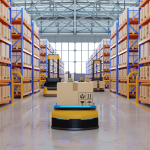From port shutdowns to labor strikes, crisis events are no longer occasional anomalies, they’re a structural feature of global logistics. Traditional rerouting processes are too slow for today’s volatility. To stay ahead, companies are turning to AI-enhanced digital twins, enabling real-time scenario modeling, risk-adjusted routing, and dynamic supplier reallocation when primary paths collapse.
Digital Twins in Real-Time Crisis Response
Next-gen logistics networks are increasingly powered by digital twins—virtual replicas of transport lanes, carrier performance, inventory locations, and node-level constraints. These twins simulate disruptions at the route or network level, allowing AI to test rerouting strategies and recommend execution pathways with minimal manual intervention.
In the early days of the Baltimore port closure in March 2024, major U.S. importers including Home Depot and Maersk leveraged digital twin platforms to reassign vessel calls to New York and Norfolk within hours. AI models factored in berth availability, drayage capacity, and inland warehouse inventory to avoid blind diversions.
Similarly, during the 2023 UPS labor negotiations, several Fortune 500 retailers used real-time shipment modeling to pre-clear alternate carriers and prep transload options in case of a strike—helping them shift volumes overnight once picket lines formed.
These systems draw on live data feeds from vessel tracking, weather alerts, carrier telemetry, and customs queues, enabling logistics teams to evaluate not just whether to reroute—but how to do so without compounding cost, service delays, or compliance exposure.
The New Contingency-Routing Playbook
Live Scenario Modeling: Logistics teams must move beyond static contingency plans. Digital twins should be stress-tested weekly with synthetic disruptions—such as sudden cross-border delays or fuel shortages—to expose failure points and validate rerouting logic under load.
Multi-Modal Substitution Logic: AI-driven routing engines should evaluate modal shifts in real time—e.g., port-to-rail or air-to-truck—based on lane-specific congestion, emissions goals, or inventory urgency. The goal is not just to reroute, but to reroute smartly, aligning decisions with operational and financial thresholds.
Proactive Capacity Booking: Leading firms now pre-secure backup capacity across modes and regions via AI-driven forecasts of risk-prone corridors. Some logistics teams even maintain “dark routing plans” that activate when crisis thresholds—like strike alerts or cyclone proximity—are triggered.
Customs and Trade Compliance Sync: Contingency routes often introduce new compliance variables—different HS codes, tax zones, or documentation regimes. AI-powered routing tools should flag regulatory impacts in tandem with physical routing options, ensuring compliance isn’t an afterthought.
Cross-Functional Command Activation: Crisis-mode routing must be a joint decision. Supply chain control towers now integrate procurement, compliance, finance, and logistics into real-time incident command centers. AI can provide routing options, but human leaders must weigh trade-offs in cost, service, and exposure.
From Static Maps to Dynamic Routing Intelligence
Too many logistics networks still rely on brittle contingency maps and manual escalation flows. In an era of overlapping disruptions—from geopolitical flare-ups to cyber sabotage—such lag is costly. AI-enhanced routing flips the model: instead of reacting to blocked lanes, the network senses, simulates, and adapts. For logistics leaders, the goal isn’t just visibility—it’s velocity. Crisis response must become a core design feature, not a last-mile improvisation.







